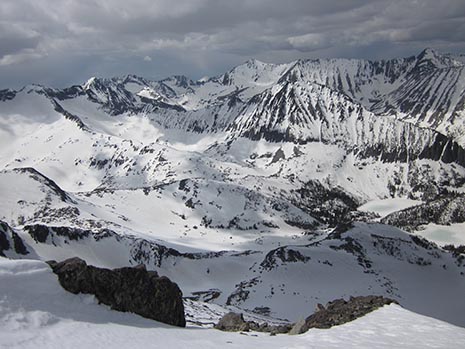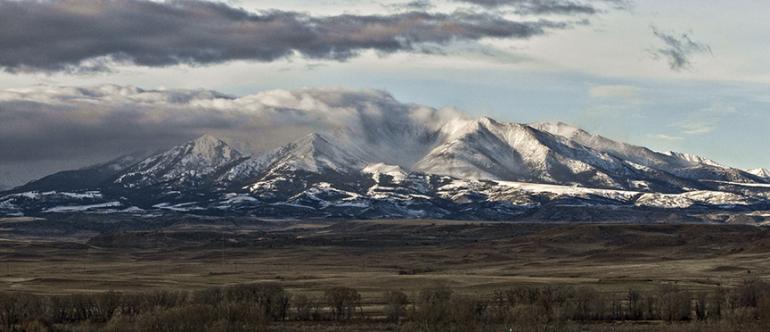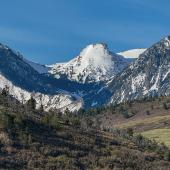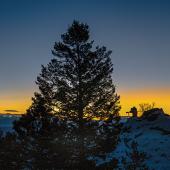History isn't always pretty.
It was a bright, warm day in the summer of 1846 when the Morgan family decided to take a break from their wagon travels. Crossing the vast eastern plains of Montana on their way to resettle in Oregon, the hardy family of five came under the shadow of the vast Crazy Mountains. They were in awe at the enormity of this range rising sharply and steeply before them, towering more than 6,000 vertical feet from the prairie below. So they quickly built a lean-to on the Musselshell River and settled in for a few days of much-needed rest.
It happened not three days later. After supper one evening, Mr. Morgan ventured out to retrieve the oxen. When he didn't return, Mrs. Morgan, unaware of any danger, sent her two boys and only daughter out to find him. After a few minutes she heard screaming. She quickly grabbed the wood-chopping ax and went out into the wilderness in the direction of the screams.
What she found was her family being raped and murdered by the Blackfeet. In that moment, it is said that Mrs. Morgan turned wild and raised the ax above her head, splitting several Blackfeet heads wide open as she swung in fury at them. She killed four warriors and the rest fled, leaving Mrs. Morgan screaming in pain at the violent death of her family.
Over time, word spread about the massacre. A few mountain men brought her food as they passed through. The Blackfeet never bothered her again out of fear that she had been touched by evil that day. It wasn't long before she herself perished. But both the Native Americans and mountain men had already begun referring to the rugged peaks above the wild woman's lean-to as the "Crazy Mountains," and the name stuck.
Today, this old tale is the most widely accepted explanation of how the Crazy Mountain range got its name. When I asked around, most of the stories I heard went something like, "Well, some woman went crazy and ran for the mountains." The details, it seems, fade with time.
Many other stories exist. As one Livingston gentleman put it while sipping a beer at the the Murray, "I heard some old gal just outside Big Timber freaked out when she saw the Crazies and the huge obstacle of crossing 'em, that she jumped out of her wagon, pulled out her hair, and went screaming into the mountains." That's an interesting one for sure. (Even more interesting is how I heard no tales of men freaking out like that.)

There was one myth, though, about a guy named Samuel. He was part of the Lewis & Clark Expedition and evidently had wandered from the trail into the mountain range and was never seen again. What was found was his journal, full of frightening experiences of headless ghosts, demons in the night, and talking animals.
And if you venture into the Clyde Park area, some folks over there tell the story about how all the "not-right-in-the-head Indians" (abnormal genes, presumably) were sent into the mountains to live as outcasts.
One tale that I like is about a medicine woman. Native Americans always had medicine men and each tribe's medicine man was born into the position. One day a woman rose at a tribe meeting and said "I am the medicine woman." This was unheard of and the tribe ridiculed her. Determined to prove her birthright, she went out into the wilderness of the mountains. She never returned and the tribe said, "Aye, that woman crazy. She go live in Crazy Mountains."
What makes the most sense, however, is the healing spirit of the mountains. This belief became popular after Chief Plenty Coups of the Crow went on a four-day vision quest, fasting and cutting off the tip of his index finger. What his vision revealed to him was of the white man coming, domestic cattle replacing the bison, and himself childless and living into old age in a log cabin. All his visions came true, and the natives cherished these mountains because of it.
So when white people came to the region, they asked the natives what they called these mountains. Not understanding each other's languages, they had to communicate in sign language. The natives tried to tell them that the mountains were a place of visions. Imagine the natives waving their hands around, pointing to the sky, wide-eyed, while raising their arms above their heads, over and over. According to David Strong in his book, Crazy Mountains: Learning from Wilderness to Weigh Technology, the perplexed whites interpreted these signs to mean a place where people just went crazy.
The truth of the matter is that no one really knows the truth about how the Crazy Mountains got their name. I say make up a story and see if it comes back to you. Like maybe they were named the Crazies to make people like us go crazy wondering why.
Editor's note: Another explanation, offered by Livingston archeologist Larry Lahren, is that the Crow noted the wild, unpredictable weather within this rugged range and called them the Crazy Mountains for that reason. This theory was corroborated by a Native American named John Frost who consulted some tribal elders on the matter. According to Frost, the old-timers all referred to the highest peak in the range as Ahwahhawa Peak, or "Mad Mountain."





